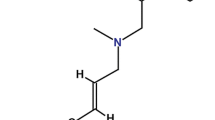Abstract
Fenticonazole is an imidazole derivative with a broad spectrum of antimycotic ctivity against dermatophytes and yeasts in in vitro and clinical studies. Fenticonazole exerts its unique antimycotic mechanism of action in the following three ways: (i) inhibition of the secretion of protease acid by Candida albicans; (ii) damage to the cytoplasmic membrane; and (iii) by blocking cytochrome oxidases and peroxidises. Fenticonazole has also been shown to exhibit antibacterial action, with a spectrum of activity that includes bacteria commonly associated with superinfected fungal skin and vaginal infections, and antiparasitic action against the protozoan Trichomonas vaginalis. Therefore, fenticonazole may be an ideal topical alternative to multi-agent treatment of mixed infections involving mycotic, bacterial, dermatophyte and/or Trichomonas spp.
Open-label clinical studies show that fenticonazole, in different pharmaceutical preparations administered once or twice daily, is effective in the treatment of superficial mycoses of the skin. In particular, fenticonazole is very effective (often with 100% of patients achieving a negative mycological assay) in pityriasis versicolor and candidiasis. For example, a large (n = 760) study showed fenticonazole 2% cream, spray or powder to be associated with a mycological response in 100% of patients with pityriasis versicolor, 96.3% of those with tinea infections and 95.2% of patients with Candida infections. Comparative clinical studies show fenticonazole once or twice daily to be at least as effective as six different topical antimycotics (miconazole, clotrimazole, econazole, bifonazole, naftifine and cyclopyroxolamine) in the treatment of superficial mycoses of the skin. Intravaginal administration of fenticonazole is associated with a high rate of microbiological efficacy in patients with vaginal candidiasis, trichomoniasis, mixed infection and bacterial vaginosis. Intravaginal fenticonazole is at least as effective as clotrimazole and shows similar efficacy to miconazole in patients with vaginal candidiasis. Fenticonazole has a rapid onset of action and clinical efficacy is generally observed within days of commencing treatment.
Topical fenticonazole is very well tolerated; adverse events are generally mild to moderate in severity and transient. The most frequent adverse events are burning sensation/cutaneous irritation and itch when applied to the skin. In a large, open-label study in superficial mycoses of the skin, the incidence of adverse events was <5% and these were rarely responsible for treatment discontinuation. Burning sensation is the most common adverse event seen with fenticonazole when administered intravaginally. However, this symptom of vaginal fungal infection was often present in patients prior to drug administration.
Given the rising incidence of superficial fungal, and possibly mixed, infections, topical fenticonazole represents an important part of the topical antimycotic armamentarium.




Similar content being viewed by others
References
Garber G. An overview of fungal infections. Drugs 2001; 61 Suppl. 1: 1–12
Fromtling RA. Overview of medically important antifungal azole derivatives. Clin Microbiol Rev 1988 Apr; 1(2): 187–217
Veronese M, Salvaterra M, Barzaghi D. Fenticonazole, a new imidazole derivative with antibacterial and antifungal activity: in vitro study. Arzneimittelforschung 1981; 31(12): 2133–7
Naud P, Matos J, Hammes L, et al. Efficacy and tolerability of fenticonazol for bacterial vaginosis treatment: double-blind study, randomized, prospective, compared to placebo [in Portugese]. Rev Bras Med 2003; 60(1–2): 67–70
Costa A, Veronese M, Ruggeri P, et al. Ultrastructural findings of Candida albicans blastoconidia submitted to the action of fenticonazole. Arzneimittelforschung 1989 Feb; 39(2): 230–3
Costa AL, Valenti A, Veronese M. Study of the morphofunctional alterations produced by fenticonazole on strains of Candida albicans, using the scanning electron microscope (S.E.M). Mykosen 1984 Jan; 27(1): 29–35
Angiolella L, De Bernardis F, Bromuro C, et al. The effect of antimycotics on secretory acid proteinase of Candida albicans. J Chemother 1990 Feb; 2(1): 55–61
Ghannoum M, Abu Elteen K. Correlative relationship between proteinase production, adherence and pathogenicity of various strains of Candida albicans. J Med Vet Mycol 1986 Oct; 24(5): 407–13
Cohen J. Review of the latest treatments of vulvovaginal mycoses: role of fenticonazole nitrate (Lomexin) in their treatment [in French]. Contracept Fertil Sex 1997 May; 25(5): 396–403
Jones BM, Geary I, Lee ME, et al. Comparison of the in vitro activities of fenticonazole, other imidazoles, metronidazole, and tetracycline against organisms associated with bacterial vaginosis and skin infections. Antimicrob Agents Chemother 1989 Jun; 33(6): 970–2
Albanese G, Di Cintio R, Giorgetti P, et al. Recurrent tinea pedis: a double blind study on the prophylactic use of fenticonazole powder. Mycoses 1992 May–Jun; 35(5–6): 157–9
Altmeyer P, Luther H, Klaschka F, et al. A double-blind clinical trial of fenticonazole cream versus naftifine cream applied once daily in patients with cutaneous mycosis. Curr Ther Res Clin Exp 1990; 47(1): 32–42
Altmeyer P, Nolting S, Kuhlwein A, et al. Effect of fenticonazole spray in cutaneous mycosis: a double-blind clinical trial versus cyclopyroxolamine spray. J Int Med Res 1990 Jan–Feb; 18(1): 61–7
Aste N, Pau M, Cordaro CI, et al. Double-blind study with fenticonazole or bifonazole lotions in pityriasis versicolor. Int J Clin Pharmacol Res 1988; 8(4): 271–3
Athow-Frost TA, Freeman K, Mann TA, et al. Clinical evaluation of fenticonazole cream in cutaneous fungal infections: a comparison with miconazole cream. Curr Med Res Opin 1986; 10(2): 107–16
Clerico R, Ribuffo A. Efficacy and tolerance of fenticonazole versus miconazole cream. Int J Clin Pharmacol Res 1987; 7(1): 77–81
Finzi A, Fioroni A, Monici Preti P, et al. A double blind evaluation of fenticonazole cream 2% and clotrimazole cream 1% in dermatomycoses. Mykosen 1986 Jan; 29(1): 41–4
Jung EG, Bisco A, Azzollini E, et al. Fenticonazole cream once daily in dermatomycosis, a double-blind controlled trial versus bifonazole. Dermatologica 1988; 177(2): 104–8
Kokoschka EM, Niebauer G, Mounari M, et al. Treatment of dermatomycoses with topical fenticonazole and econazole. Mykosen 1986 Jan; 29(1): 45–50
Leiste D, Braun W, Fegeier W, et al. A double-blind clinical trial of fenticonazole (2%) spray versus naftifine (1%) spray in patients with cutaneous mycoses. Curr Med Res Opin 1989; 11(9): 567–75
Odeh F, Fabry H, Kuhlwein A, et al. A double-blind clinical trial with a single daily application of fenticonzole lotion versus econazole lotion in patients with cutaneous mycosis. Curr Ther Res Clin Exp 1990; 47: 22–31
Rabbiosi G, Di Silverio A, Mosca M, et al. Treatment of Pityriasis versicolor with foam formulation of two different imidazole derivatives, fenticonazole and econazole. Derm Clin 1989; 3: 169–74
Stetter H. Fenticonazole (2% cream) in the treatment of skin diseases due to dermatophytes. Acta Therapeutica 1984; 10: 241–8
Vannini P, Difonzo EM, Cordaro CI, et al. New therapeutic approach in skin mycoses: a comparative trial once versus twice daily application of fenticonazole in comparison to miconazole. Mycoses 1988 May; 31(5): 280–4
Aste N, Pau M, Zucca M, et al. Clinical experience with fenticonazole 2% formulation in the treatment of dermatomycoses and pityriasis versicolor. Int J Clin Pharmacol Res 1987; 7(6): 503–6
Di Silverio A, Mosca M, Brandozzi G, et al. Efficacy of fenticonazole in patients with pityriasis versicolor [in Italian]. G Ital Dermatol Venereol 1989 Sep; 124(9): XLVII–L
Fioroni A, Altomare GF, Finzi AF. Esperienza con fenticonazolo crema in unica applicazione giornaliera nelle micosi superficiali. Ann It Derm Clin Sper 1987; 41: 311–6
Persi A, Rebora A. Fenticonazole: a clinical trial. Mykosen 1985 Apr; 28(4): 206–9
Pizzino D, Negosanti M, Morganti L, et al. Therapeutic efficacy of fenticonazole and in vitro assessment of its antifungal activity in comparison with other imidazole derivatives [in Italian]. G Ital Dermatol Venereol 1988 Sep; 123(9): XLV–XLVIII
Sartani A, Cordaro CI, Panconesi E. A multicenter trial with a new imidazole derivative, fenticonazole, in superficial fungal skin infections. Curr Ther Res Clin Exp 1988; 43(6): 1194–203
Clerico R. Therapeutical activity of a new imidazole, the fenticonazole, in superficial mycoses [in Italian]. Dermatol Clin 1986; 6: 87–90
Fioroni A, Terragni L, Vannini P, et al. Fenticonazole plasma levels during treatment with fenticonazole 2% cream and spray in patients with dermatomycoses. Curr Ther Res Clin Exp 1990; 47(6): 997–1003
Fusetti M, Trimarchi I, Eibenstein A. New therapeutic acquisition in the treatment of otomycosis: an experimental study [in Italian]. Otorinolaringologia 1990; 40(5): 393–8
Lepine J, Sacchetta A, Vargiu G, et al. Safety and efficacy on skin mycoses of a new imidazole derivate: fenticonazole. A report on 28 patients. Med Praxis 1984; 4: 1–7
Veronese M, Bertoncini A, Preti PM. Evaluation of the skin retention time of imidazole derivatives. Mykosen 1987 Aug; 30(8): 386–90
Lopez-De-Blanc SA, Salati-De-Mugnolo N, Femopase FL, et al. Antifungal topical therapy in oral chronic candidosis: a comparative study. Med Oral 2002 Jul–Oct; 7(4): 260–70
Brewster E, Preti PM, Ruffmann R, et al. Effect of fenticonazole in vaginal candidiasis: a double-blind clinical trial versus clotrimazole. J Int Med Res 1986; 14(6): 306–10
Gorlero F, Bosco P, Barbieri M, et al. Fenticonazole ovules in the treatment of vaginal Trichomonas infections: a double-blind randomized pilot clinical trial. Curr Ther Res Clin Exp 1992; 51: 367–76
Gorlero F, Macchiavello S, Pellegatta L, et al. Evaluation of the efficacy and tolerability of two different dosages of fenticonazole vaginal ovules (600mg and 1000 mg) in patients with vaginal trichomoniasis: a controlled, double-blind, randomized clinical trial versus placebo. Curr Ther Res Clin Exp 1994; 55(5): 510–8
Studd JW, Dooley MM, Welch CC, et al. Comparative clinical trial of fenticonazole ovule (600 mg) versus clotrimazole vaginal tablet (500 mg) in the treatment of symptomatic vaginal candidiasis. Curr Med Res Opin 1989; 11(8): 477–84
Wiest W, Azzollini E, Ruffmann R. Comparison of single administration with an ovule of 600mg fenticonazole versus a 500mg clotrimazole vaginal pessary in the treatment of vaginal candidiasis. J Int Med Res 1989 Jul–Aug; 17(4): 369–72
Belaisch J. Evaluation of the time response of a single dose administration of fenticonazole nitrate [in French]. Contracept Fertil Sex 1996 May; 24(5): 417–22
Bukovsky I, Schneider D, Arieli S, et al. Fenticonazole in the treatment of vaginal trichomoniasis and vaginal mixed infections. Adv Ther 1991; 8: 166–71
Fernandez-Alba J, Valle-Gay A, Dibildox M, et al. Fenticonazole nitrate for treatment of vulvovaginitis: efficacy, safety, and tolerability of 1-gram ovules, administered as ultra-short 2-day regimen. J Chemother 2004 Apr; 16(2): 179–86
Lawrence AG, Houang ET, Hiscock E, et al. Single dose therapy of vaginal candidiasis: a comparative trial of fenticonazole vaginal ovules versus clotrimazole vaginal tablets. Curr Med Res Opin 1990; 12(2): 114–20
Munoz Reyes JR, Villanueva Reynoso C, Ramos CJ, et al. Efficacy and tolerance of 200mg of fenticonazole versus 400mg of miconazole in the intravaginal treatment of mycotic vulvovaginitis [in Spanish]. Ginecol Obstet Mex 2002 Feb; 70: 59–65
Sartani A, Cordaro C, Adinolfi G, et al. Short-term treatment of vaginal candidiasis: results of a multi-center study [in Italian]. Riv Ost Gin Perin 1988; 3(2): 184–9
Schneider D, Caspi E, Arieli S, et al. Fenticonazole in the treatment of vaginal candidiasis. Adv Ther 1990; 7: 355–61
Wiest W, Ruffmann R. Short-term treatment of vaginal candidiasis with fenticonazole ovules: a three-dose schedule comparative trial. J Int Med Res 1987 Sep–Oct; 15(5): 319–25
De Cecco L, Gorlero F, Marre Brunenghi MC, et al. Studio multicentrico sull’efficacia e tollerabilita del fenticonazolo nel trattamento delle vulvovaginiti da Candida. Int J Drug Ther 1988; 5(4): 296–301
Scalambrino S, Colombo M, Pellegrino A, et al. Efficacy and tolerability of intravaginal fenticonazole single therapeutic shot in low-recurrent vaginal trichomoniasis and candidiasis [in Italian]. Giorn Ital Mal Inf 1996; 2: 37–40
Scienza G, Bulgheroni C, Confalonieri C. Vaginiti recidivanti: efficacia e tollerabilita della terapia locale con fenticonazolo. G Ital Ost Gin 1987; 9(9): 758–60
Acknowledgements
Medical writing assistance was provided by Neil Reynolds and Mary Hines of Wolters Kluwer Health Medical Communications with funding from Recordati. The authors have declared that they have no conflicts of interest that are directly relevant to the content of this review.
Author information
Authors and Affiliations
Corresponding author
Rights and permissions
About this article
Cite this article
Veraldi, S., Milani, R. Topical Fenticonazole in Dermatology and Gynaecology. Drugs 68, 2183–2194 (2008). https://doi.org/10.2165/00003495-200868150-00007
Published:
Issue Date:
DOI: https://doi.org/10.2165/00003495-200868150-00007




